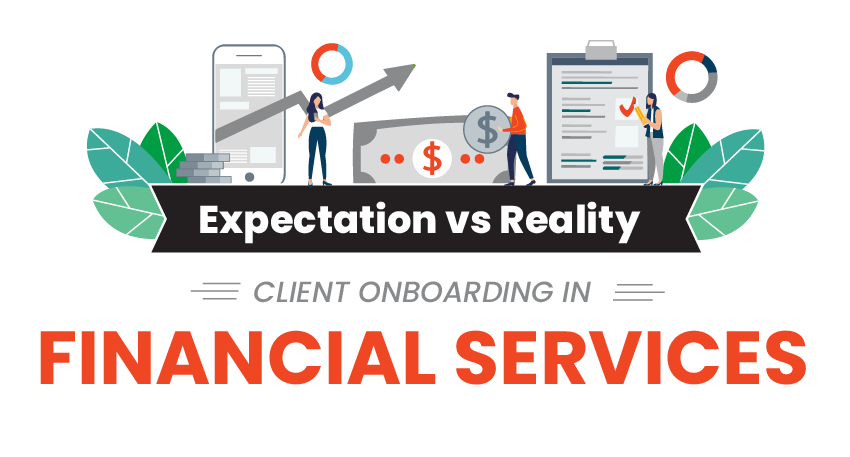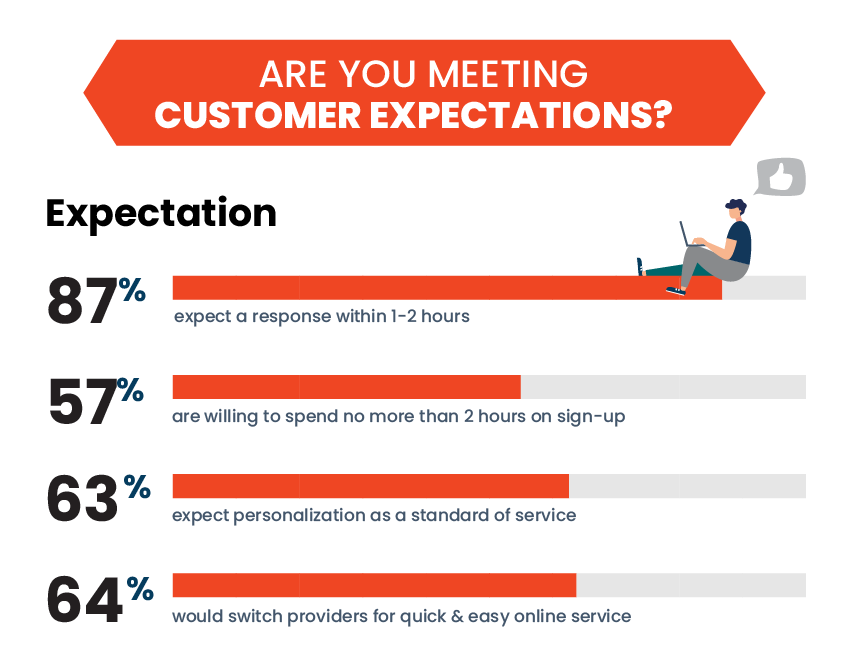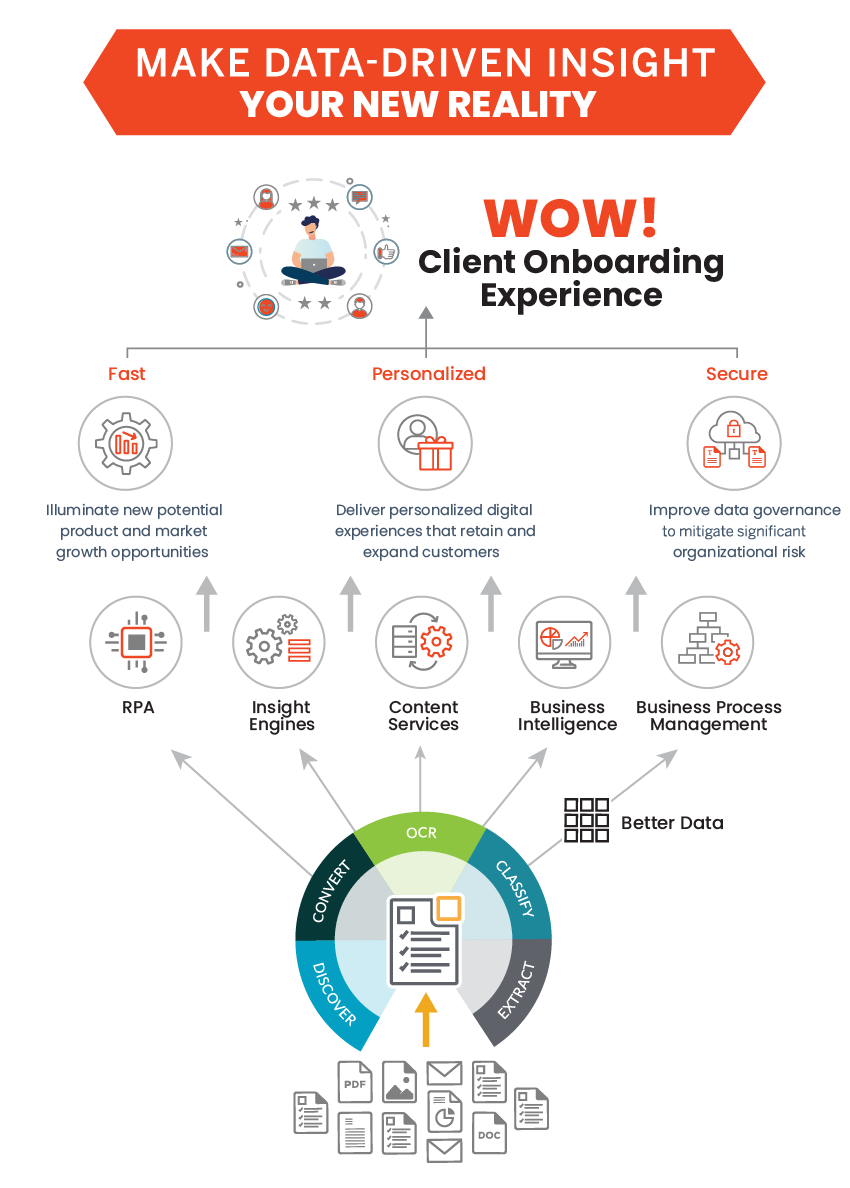3 Key Principles for Creating an Effective Client Onboarding Experience

You never get a second chance to make a great first impression. For financial service organizations struggling to compete with new digital-born competitors, this old maxim couldn’t ring truer.
As born-digital firms gain a foothold on the industry—and customers demand faster, better service on all fronts—financial service organizations are intent on setting a positive tone from initial outreach to account open and beyond.
When it comes to client onboarding, however, customer expectations and reality tell two different stories altogether. How can banking and insurance organizations better understand and deliver on shifting customer expectations? Keep reading to understand what’s driving customer expectations and learn the three fundamental principles for creating a world-class client onboarding experience.
Client Onboarding: Expectation vs. Reality
If you’ve recently signed on for a new banking or insurance product/service, then the slog of filling out countless forms and entering the same information over and over again might sound familiar. The traditional client onboarding process is directly at odds with the needs and expectations of today’s consumers, who, due to the proliferation of on-demand mobile services—whether it’s ride sharing, meal delivery, or even life insurance—want it fast and want it without friction. Are today’s consumers demanding? By all accounts, many would say yes.

Regrettably, banking and insurance organizations are falling short of delivering the seamless client onboarding experience that customers expect.
- 38% of would-be customers drop out of the onboarding process because of the frustration with paper or the volume of information required2.
- From outreach to account open, it could take days or weeks to complete the onboarding process.
- To add insult to injury, many new customers are sent generic product/service offers that are completely irrelevant.
There’s no question that looking under the hood of your organization’s client onboarding processes can prove a fruitful and profitable endeavor.
Companies that get client onboarding right are richly rewarded with improved customer loyalty and lower operational costs. Brands that take steps to improve the customer experience also stand to increase revenue by 10-15 percent and reduce costs by 15-20 percent.3
Speed, Personalization & Security: The Holy Trifecta of Client Onboarding
To close the loop on customer expectations and the current reality of your organization’s client onboarding experience, you must take steps to bring speed, personalization, and security to every facet of the client onboarding process.

1. Speed
Many financial institutions and insurance companies work at a snail’s pace relative to what their clients expect. Follow-up questions, documentation validation, and requests for additional information create further delays and frustration. Reviewing and approving applicant data—and issuing, completing, and storing reams of paperwork—happens at a glacial stride. But as the statistics above show, a failure to make the customer onboarding process fast and efficient means that many clients will simply take their business elsewhere. Speed and simplicity are key components of a winning client onboarding experience.
2. Personalization
Whether it’s understanding their current needs or anticipating future goals, most consumers expect personalization as a standard of service. And yet many complain that their providers don’t know them well enough: Most organizations treat long-time clients like net-new customers by delivering offers for products or services the customer already holds. When clients do wish to upgrade, they’re required to complete paperwork and applications that ask for information they have already provided.
The type of data you collect at the outset—and what you do with it—dictates your ability to provide the seamless service that shows customers you understand their needs implicitly. Businesses must think beyond the type of data they collect during the onboarding process and ensure that customer data is unified and securely accessible to relevant teams across the organization.
3. Security
Consumers are more concerned about data security than ever, and for good reason: Data breaches are increasingly prevalent, and the sensitive information that banks and insurance companies hold can put customers at risk for identity theft and other losses. At the same time, highly sensitive information such as social security numbers are often required during onboarding.
There is no greater opportunity than during the earliest stages of the client relationship to get security right. Instead of allowing sensitive data to get lost deep within customer files, it’s important at the outset—right at the time of collection—to take steps to contain Personally Identifiable Information (PII). Onboarding is also a great opportunity to set the foundation for trust with new customers. As you solicit sensitive information, you can provide clear information detailing how that data will be stored, utilized, and protected.
Proven Success
For a Fortune 100 insurance provider, slow manual workflows and lack of document searchability stalled the organization’s ability to process a higher volume of incoming policies. Unstructured and non-searchable data flowed into the organization in a variety of formats from a range of sources—from scanned images to emails, SFTPs, and through a digital dropbox. Heavy manual intervention was required to convert documents into a format fit for downstream processing.
There were 24,000 delays or stoppages in the data capture process per month for
different policies—costing the organization roughly $100 million in revenue annually, on top of the lost efficiency associated with manual workflows. The cumbersome process was prone to errors and took days for policy agents to prepare and review incoming claims delaying the response to impatient customers.
To meet its goal of increasing policy ingestion and significantly improve claims processing times, the insurance enterprise needed to adopt a new infrastructure that would allow them to automate manual processes and digitize customer service.
After testing several technologies, the insurance provider selected Adlib’s Content Intelligence
platform equipped with Data Capture, Enterprise Document Conversion and Optical Character
Recognition (OCR) industry leading capabilities.
With Adlib’s Content Intelligence platform in place, the company was able to reduce claims processing time by 95%, increase customer response time to a matter of hours, eliminate tedious data entry and error-prone manual efforts, and boost revenue.
The organization is now able to:
- Capture incoming documentation and automatically convert it into high-definition PDFs
- Reassign knowledge workers to more critical tasks
- Delete redundant, obsolete, and trivial (ROT) data by leveraging advanced de-duplication technology
- Maintain an audit trail to comply with regulatory demands, and meet short-term and long-term digital preservation (archive) objectives
Building on the efficiency of its new workflows, the organization has begun to roll out the Adlib’s Content Intelligence platform to other lines of business and divisions of the company.
Take-Home Lessons
A great client onboarding experience sets the tone for the entire customer relationship, and not getting it right can put banks and insurance organizations at a serious strategic disadvantage. To win loyal customers, banks and insurers must leverage Robotic Process Automation (RPA) tools that improve data searchability within complex documents and automate document processing. By reducing manual intervention, accelerating document-centric workflows, and bringing a greater level of agility to customer-facing processes, banks and insurers can onboard customers with speed, security, and personalization.
References:
1Adlib Software, How Important is Customer Onboarding for Banking and Insurance Customers? (SurveyMonkey: 2019)
2Deloitte: Digital Onboarding for Financial Services: A Must-Have for Digital Natives
3McKinsey & Company: Best of both worlds: Customer experience for more revenues and lower costs



